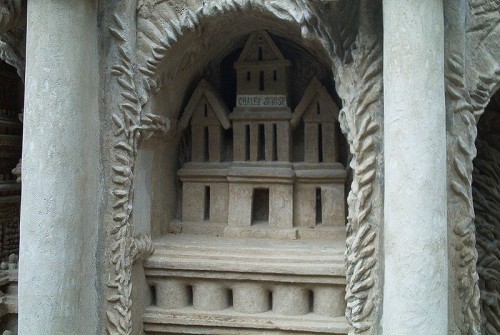I Like __ A Lot
Geography Thursday: A Place of Dreams
A non-magic magic story: In April 1879, a French postman tripped on a stone while he was delivering mail. Inspired by its shape, form, texture, whatever, he picked it up. From that day forward, this postman, named Ferdinand Cheval, collected rocks in a wheel barrel after work, and from these rocks he built a palace. I wanted to use the word “castle” to emphasize the magic component, but “palace” is just as sufficient. He called it Palais Ideal, his Ideal Palace. It took him thirty-six years. Below, you’ll find images, lots of them. They are glorious.
 A non-magic non-magic story: Cheval’s neighbours said he was insane. They laughed at him, mocked him, called him all sorts of names, none of which were kind or generous.
A non-magic non-magic story: Cheval’s neighbours said he was insane. They laughed at him, mocked him, called him all sorts of names, none of which were kind or generous.
A magic non-magic story: Cheval’s Palais Ideal inspired many thinkers and artists. Guy DeBord (and many Situationists) made pilgrimages to the palace. (I can’t find a photograph on-line, but if this suits your fancy, Verso recently published a handsome book of essays called The Situationists and the City that has many lovely but grainy photos of DeBord at the palace.) Andre Breton and the Surrealists also found inspiration there. (There are photos of Breton at Palais Ideal in the Verso book as well.) Apparently, Cheval’s palace also beckoned unnotable people like Pablo Picasso, Anais Nin, and Max Ernst.
A semi-conclusion: Cheval’s Wikipedia page describes Palais Ideal as “naïve art” architecture, which is defined as: “a classification of art that is often characterized by a childlike simplicity in its subject matter and technique.” But looking at Palais Ideal, what is childlike about it? The only thing I can conclude is that by aiming to manifest a utopia, Cheval was being “childlike.” Is utopia inherently childish then? Is a desire for an ideal place childish?
Another semi-conclusion: In The Situationists and the City, editor Tom McDonough perpetually calls Cheval “the postman Cheval” or “the postman.” On rare occasion, he uses only his last name. That is, there is always a modifier, a reminder of his occupation. This may have been to emphasize to readers that he was not an architect, but to what end? I personally found it condescending. Writers and thinkers and “real” architects can be known by their last names alone. When he talks about DeBord or Breton, he does not add an occupation before their names. But because Cheval was a postman, we needed it why? For instance, can you imagine if we began any sentence about Bukowski as “the postman Bukowski” or every sentence about Eliot with “the banker Eliot”? It would be ridiculous. Unlike Bukowski and Eliot, Cheval has no lasting “art” other than his palace, which is treated not as “art” but as “naïve art.” What does this say about occupation? What does this say about the hierarchies of art? Because of Cheval’s lack of formal training in architecture, should his palace be deemed less artistic than, say, this:
Or this:
A conclusion, or, a question: If you were to build your own Palais Ideal, what material would you use? What would it look like? Try not to be too childish, won’t you? Lord knows, we wouldn’t want to be naïve in our dreaming.
Tags: architecture, Cheval, Geography Thursday, palais ideal, utopia






wow that thing’s beautiful. will have to check out that book too, it sounds good.
and i don’t think that the author is suggesting that utopia is necessarily childish but rather that this version of an ideal place is childish. (to suggest that utopia = childish = a bit of fallacious reasoning (at least as the argument was presented here)). in fact, i bet he would say other versions of utopia (like constant’s new babylon; who was a situationist too) are not naive. it seems to me the author was biased about the palace and it sounds like it’s due to the usual hierarchies. art, as we all know, is determined by context. (sadly?)
my own palais ideal? thick quilts draped over a bunch of chairs. maybe.
ahh yess! i’ve been reading a lot about these kinds of places.
one of my favs is nek chand:
http://www.google.com/images?client=safari&rls=en&q=nek%20chand&oe=UTF-8&um=1&ie=UTF-8&source=og&sa=N&hl=en&tab=wi&biw=1224&bih=668
in secrecy, he built a 12 acre (now 18) sculpture garden out of recycled materials and it almost got torn down. i saw a similar recycle art garden in philly once…
this book also has pictures/info on many of these places:
http://www.amazon.com/Fantasy-Worlds-French-John-Maizels/dp/3822832197/ref=sr_1_1?ie=UTF8&qid=1294932210&sr=8-1
that said, i think using “postman” as a qualifier whenever referring to Cheval probably has a lot to do with the fetishization of “outsider” artists. i won’t say much about this, but i have spent a lot of time thinking about the politics of outsider art and notions of naivety and authenticity.
lately i’ve been moving to much to really make my space, but i always usually make a crazy magical wonderland forts in my room to sleep in… i used to just collect stuff from the free table at my school. other than collected trinkets, i used lots of yarn, thrift store scarves, Christmas lights, cardboard, toy instruments, paint, etc. i’ve never been good at using industrial materials. my old fort used to be called the “cuddle punk liberation love shack” and i would try to lure ladies into it for cuddle sessions hahaha
Stones. There is a river across the road from my mom’s house, and she owns a great deal of land. I’d to spend years hauling stones, nice wide flat river stones from the banks and make an enormous garden, with gazebos and pavilions and maybe a greenhouse.
Stones. There is a river across the road from my mom’s house, and she owns a great deal of land. I’d to spend years hauling stones, nice wide flat river stones from the banks and make an enormous garden, with gazebos and pavilions and maybe a greenhouse.
Aha! my Palais Ideal. It is my house, my way, my floors, my anywhere, where my children are always safe and warm, and I can kiss their cool hair while they sleep, smell their sweaty necks. I run and run and run to try to stay in this one place – it can not last.
I’d like to believe he fetishizes “outsider” artists, but really, it was just condescending.
I’m working on a post (it’ll probably go up tomorrow) on authenticity. What are you thinking about it? Find me on gmail chat!
I’d like to believe he fetishizes “outsider” artists, but really, it was just condescending.
I’m working on a post (it’ll probably go up tomorrow) on authenticity. What are you thinking about it? Find me on gmail chat!
It was the wikipedia article that said it was “naive art,” not any person in particular. Whereas I accept that there is a fallacy in my eliding of naivete/childishness and utopian, it is not without precedent for one to consider utopianism as naive. (My partner studies utopias, so I hear about this stuff with some regularity.) The Verso book – or the bit of it I’ve read – discusses Constant’s New Babylon too! But I’m not far enough to say anything about it, only that they did not qualify Constant, like they did Cheval.
And: I like your palais ideal!
How about “the drunkard Debord”? He’d probably like that.
I would use the dreams of all past revolutions–and lots of candy. Lily? Have you read stuff by the situationists? They loved the building you’re writing about.
Hi Janey, I have read what the Situationists have written about him! They were very “into” Cheval (which is actually how I came across him). What I find fascinating about Cheval is how different people interpret his palace: the Situationist & Surrealists loved him, his neighbours thought he was a quack. (Probably, the Situationists’ & Surrealists’ neighbours thought they were quacks too!) Maybe my use of the word “quack” would work well with Kyle Minor’s post above this one!
Sabato (“Simon”) Rodia worked on the Watts Towers from 1921 to 1954.
Sabato (“Simon”) Rodia worked on the Watts Towers from 1921 to 1954.
Sabato (“Simon”) Rodia worked on the Watts Towers from 1921 to 1954.
for a second before I looked closer and scrolled down I thought it was Angkor Wat.
super cool.
for a second before I looked closer and scrolled down I thought it was Angkor Wat.
super cool.
for a second before I looked closer and scrolled down I thought it was Angkor Wat.
super cool.
Elastic band bungalow.
i *think* i added you to gchat… i still am not totally sure how to do it, haha.
the concept of “outsider” art is totally bizarre to me. it relies on a clear boundary between who is inside and who is outside (which has been hotly contested at outsider art fairs), and i think–with contemporary art being a lucrative industry and all–there are certain folk who are extremely invested in policing the boundary and maintaining notions of authenticity for the sake of inflating the value of art objects. i am suspicious of the way external discourses are generated to produce artistic/monetary value, though i tend to like art typically marked as “outsider” (because such artists have THE PASSION, a quality i value) and i enjoy knowing about the artists i like. the power-dynamic between the artist and the appreciators/curators/dealers troubles me a bit–and it definitely can manifest itself a kind of condescension. art dealers often prey on and exploit vulnerable people; like evil vampires, haha. i suppose i am critical of the idea because i t amplifies “otherness” and promotes a sense of appreciation founded on that otherness… and i want to appreciate thing in a more equal way, if that makes sense.
most of this probably doesn’t apply to the cheval case, though some of it might.
i saw this piece in the national museum in DC some years ago, can’t for the life remember its name or who made it, but won’t ever forget its size, its overwhelmingness: as part of an ‘american folk art’ display, nearly half an entire wing had been taken up by this guy’s shrine he built out of aluminum and scrap cardboard in his garage over a period of (i think) 50 years. he was a postman too (i think) and had shaped all these shimmering thrones and trinkets of antiquity made out to a ‘Lord’; again, the size and all those details, it really struck me, and came back to it at least two times while meandering about the museum with a friend. damned if i can remember who made it..
oh, questions:
If you were to build your own Palais Ideal, what material would you use?
computers
What would it look like?
either a pyramid or as close to a sphere as possible
I personally see the potential for condescension in terms such as ‘art brut’, ‘naive art’, or ‘outsider art’, but I don’t know if it’s inherent in them. It seems to me an important distinction to make, in several respects, that the guy was just a postman who figured all of this out on his own, and in fact I’ve seen the phrases more often used in a complementary or (on occasion) aggrandizing sense.
If it is not one which is intended (implicitly or explicitly) to lessen his stature as a maker, I think it’s an important distinction to make.
xrl.us/bh8nzm
havent the text lily tapped, i’m sure she’ll chime in, but i think the author persistently referred to Cheval as the postman, hence the problem. once would be enough. (Is it important that Place plays with law briefs much of her day? yes, but don’t get hung up…)
Lily, a thousand thanks. It feels strange to not have known about this, it is quite glorious, in sentiment, and in artifice. (artifice is a funny word too, people think it means “fake”). to sail on your thought, i struggle often on the urge to dance around asking new friends where they work. it’s precarious, because sometimes (as NLY points out), it’s important. But often it elicits grumbles, no one wants to be linked to a title, even queens sometimes.
my own? bamboo. better yet bamboo chopstick detritus reclaimed from americhinese joints and integrated with it. gonna be utopian, gotta be green and living.
NLY: Now this is just me but I find any kind of special allowances for one singular section of the non-dominant population to be condescending. “Outsider art” is a very condescending term. How can it not be? First off, just look at the words in all three examples (art brut, naive art, outsider art). The implication is that “art” is (and should be) produced by certain people in a certain space. In fact, your point “that the guy was just a postman who figured all of this out on his own, and in fact I’ve seen the phrases more often used in a complementary or (on occasion) aggrandizing sense” can also be interpreted as condescending. Why wouldn’t a postman “be able to figure out” anything “all on his own,” much less the – what? – impossible world of art and architecture? That he built *something* was not the problem. It was that he made something big, something inherently utopian. (For point of fact, if I sound especially riled up, I’m sorry. It’s because my father builds things, beautiful things, and he was a janitor for the bulk of his life in the US. People often commented on how amazing it was that he was make such intricate things, being a custodian and all. Well, folks, truth is, in another country in another language practically in another life, he went to art & design school.)
Most people don’t use dictionaries.
I think your point about Vanessa is important. Imagine in 50 years, someone writes a book about her, or even mentions her in a book, in passing, and rather than say “Vanessa Place” or “Place” or “the writer Place,” they continually write “the lawyer Place” (her last name happens to be particularly fun and open to puns, if one were so inclined, though there’s no place for that kind of joking here). But, see, it’s not really comparable. In most Western societies, lawyers are hold a position of power. Postmen, however, do not. For the sake of clarity, the phrasing throughout the chapter is “the postman Cheval.” It’s the definite article “the” that irks me. (I just realized this.) The use of this modifying identifier leaves no room of multiple identities. It makes Cheval statically “the postman” and nothing else. He can’t be neither artist or architect because he is already one identifiable thing: a humble postman.
You make a good point about occupation becoming identity.
I guess my confusion stems from the nature and origins of those terms. Those terms weren’t really meant to apply to Cheval, especially not art brut or outsider art, and ‘naive art’ is more descriptive of style than person, usually. The terms were invented to describe asylum patients, who were given art as rehabilitative or therapeutic means, and were not intended to become a part of a broad-based critical nomenclature. I frequently encounter the term in conjunction with people who treat it as a kind of vain styling, and that is my primary dislike for the term. Whether or not it is condescending when applied to the people it was intended to describe, I don’t pretend to know, but to call an asylum patient ‘outside’ (especially for the time of the term’s coinage) is painfully accurate.
I do insist, however, that if you cannot read my remark without imagining me patting the poor postman on the head, you should probably take a step back. A statement made from a state of awe cannot be condescending, because a state of awe places you below what you speak of. It’s not a terribly offensive observation that most people don’t (and couldn’t) do what he did. The idea that I should treat one man’s ingenuity as inherently equal to the generational ingenuity of many men across a tradition’s history, otherwise I will be condescending to him, is something I find strange, and a bit silly. If I’m not allowed to incorporate biography in my appreciation of these works, I don’t know how I’m supposed to enjoy art.
If you reread my remark and still insist that it was made from a potentially condescending stance, then perhaps reflect that it was in reality made from the realization (both instantaneous and profound) that, between the two of us, only one man has produced his masterwork.
Hi NYL: Ok, maybe I read your comment too harshly. What I meant to say was that we should be in awe that anyone created this place from found and collected objects. That he was a postman by occupation should be as noteworthy as the fact that I was a barrista while writing at least two of my books. That was my occupation. If anyone were to write about me in the future, it’d be swell if they said: the barrista Lily Hoang.
My frustration about this emphasis on occupation as signifier of identity (in often condescending ways) was directed at you, though it shouldn’t have been. Your comment was thoughtful.
I know very little about naive art or art brut (only the very little “research” I did online when I read your comment). I know very little about naive art. Maybe I am over-reacting in a pre-emptively offensive way, but to call Cheval’s Palais Ideal “naive art” seems to be pretty problematic, and it seems to be as much a description of the style as the person. Here, I’ll go back to the use of the word “utopia.” He built something that he called his utopia. It was a place of his dreams. I know people have harked on my conflation of utopia and naivete, but I think there IS a relationship in Cheval’s case. That, and well, sure, he was untrained. He built this massive thing because a rock caught his fancy. And that, my friend, is pretty fucking cool. (I’m pretty sure we’re on the exact same page on that one!)
Well, it may be important to remember that all three of those concepts were originally French, and the word ‘naive’ has several other connotations beyond the one we’ve adopted into English. Mostly I find it to refer specifically to the nature of the vision, which fosters either a disregard or an ignorance of specific principles of representation, first off, but also specifically mirrors or enacts the visual limitations of children in representing things–the specific way they see and capture things is what’s being referred to, and it’s mostly a term which is accorded to art and artists who are recognized as mature, and worth attention. If it also seeks to explain just exactly why these types of work and people are worth paying attention to, it’s good to remember that at the time there were very advancement notions of representation these works were flying in the face of. So, to have a girl (as a particularly famous example did) one day pick up painting, with no prior experience to it, and produce works which were soon recognized as highly compelling and even stunning, but which in many ways could not transcend the planar outlook of a child, you have to somehow account for the sensation these works are capable of evoking in you. So, in any case, I think (without having a clue what your book said) I see examples which could warrant the use of the phrase in Cheval: notice how his technique bears close resemblance to the techniques used in sand castles and sculptures? The fact that he was not a professionally trained sculptor (though, since I don’t know his life story, he very well could have studied things once he began this) is important to note because it accounts for aspects of his style–aspects which both limited and enhanced the scope of his vision, as style must do.
Also, the French have this way of choosing nicknames for their artists which can sound kind of condescending–there was a painter of some genius, by the name of Henri Rousseau, who was called ‘Le Douanier’, or ‘the customs officer’, because he was a customs officer. I get the impression the French were more amused by this than anything, and meant it very affectionately, and maybe calling Cheval ‘The Postman’ is a similar move?
I can’t speak to the book you read, so I don’t know if any of this is relevant, and I’m sorry if it felt protracted, but they were things that struck me as possible alternatives of interpretation. Thank you for showing me this man.
hey Lily,
i guess this is a little late but maybe you have the disqus function on that will send you an email. anyway, here’s a video i just found that i thought you might be into:
http://www.youtube.com/watch?v=jqyH8ueCAsY
and yeah, i guess there is something naive about utopias but there’s also something critical. i think it’s this combination that makes them interesting to me.